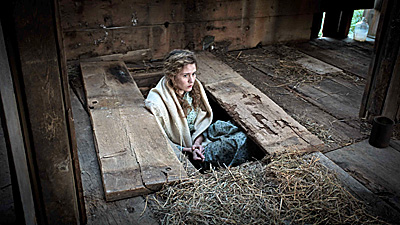By Tom Tugend, other
When Canadian filmmaker Naomi Jaye, who had spent 10 years making short films, told friends she was embarking on her first feature, they cheered.
When she added that the project would be the first Canadian movie in Yiddish, which neither she nor her lead actors knew, the friends questioned her sanity.
Five years later, the result of her perseverance is “The Pin,” a story of love and loss during the Holocaust, of faithfulness to a promise and the question of whether a sense of humanity can survive in a world transformed into a slaughterhouse.
The movie’s first scene shows Jacob, somewhere between adolescence and manhood, emerging from a hole in a forest, glancing around warily, and then running as if escaping an unseen enemy.
In the second scene, set in a morgue, an elderly shomer, who guards the body and soul of the dead until burial, reads psalms from a prayer book while occasionally glancing at a body resting on a gurney, covered by a white sheet.
In a long flashback, the shomer recalls his youth. The year is 1941, Nazi armies have overrun his hometown somewhere in Eastern Europe and have killed his family.
He finds shelter in a barn that seems empty, but soon encounters a young Jewish girl, Leah, whose family has met the same fate and who has also gone into hiding.
After initial suspicion and confrontation, the two orphans move toward each other, emotionally and physically, fall in love, and eventually conduct their own impromptu wedding ceremony.
When Leah hears of an empty train that travels “across the border,” she and Jacob plan their escape and a happy life together. But fate and a quarrel interfere, and the young lovers are separated, neither knowing what happened to the other.
What about “the pin” of the title?
Jaye says the inspiration for the story and title came from her grandmother, who had an obsessive fear of being buried alive.
As she aged, she made her son, Jaye’s father, promise that when she died, he would prick her hand with a pin, to make absolutely certain she was actually dead before placing her body in a coffin.
This story, Jaye said, “always fascinated me, because it required an act of true love that was also an act of violence.”
When Jacob, now the aged shomer, lifts the sheet and looks at the body beneath, he realizes that lying before him is his youthful love, Leah. He remembers her fear of being buried alive, his promise to her, and he starts to look for a pin.
To Jaye, the tale represents the ultimate triumph of the human spirit.She explained this assertion by noting that the chief protagonists, “caught in a terrible situation, are able to find beauty and love.”
Some viewers may find it difficult to accept this hopeful evaluation, or appreciate the extremely slow pace of the movie, marked by long, wordless pauses in semi-dark settings.
But Jaye has a cogent explanation for using this technique: “The lives of people in hiding, as for soldiers in war, are marked by long periods of waiting,” between occasional bursts of extreme action. This was the mood she was trying to convey.
Her main problem in casting the movie was the lack of any young actors in Canada who knew Yiddish.
She solved the problem, quite effectively, by putting Grisha Pasternak, who plays Jacob, and Milda Gecaite, as Leah, through a six-month Yiddish course, and the results are quite satisfying.
Both actors arrived in Canada as children, Pasternak from Ukraine and Gecaite from Lithuania. Neither is Jewish, and both show considerable talent.
